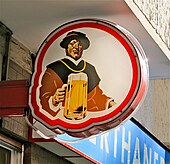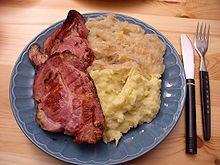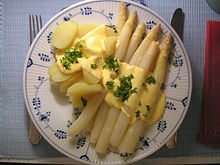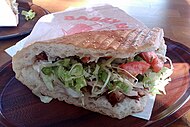Berlin cuisine
The Berlin food was until the late 19th century a simple cuisine, rather than emphasizes hearty taste and saturation refinement. In addition to the ingredients used in Brandenburg cuisine , it is shaped by the cooking traditions of the immigrants from Silesia , Bohemia , East Prussia , Pomerania and Mecklenburg as well as the Huguenots from France . What is striking - from today's perspective - is the frequent use of the noble crayfish , which enabled rich catches around Berlin in the 18th and 19th centuries.
The Prussian - Protestant Berlin cuisine often integrated these influences through simplification. Elaborate forms of preparation and refined seasoning are alien to her. Typical ingredients are pork , goose and fish such as carp , eel and pike , cabbage , legumes such as peas , lentils and beans as well as beets , cucumbers and potatoes .
history
1600-1900

Berlin only grew to a significant size in the 18th and 19th centuries. But even before that, it was a transit station and destination for people from all over Germany and beyond. The Huguenots, who were influenced by Calvinism and were accepted in the 17th century, were also particularly influential in the kitchen . They brought with them ingredients that were previously unknown to Brandenburg , such as cauliflower , asparagus , green peas and beans, cucumber and lettuce, which have since been grown in the Berlin area. Until then, cabbage and beets dominated the cultivation of vegetables on the barren, sandy soils. Teltower turnips , a small, delicate form of the white turnip, are an independent product of the poor soil that is valued to this day .
The potato order issued by Friedrich II around 1750 , which he decreed to farmers, introduced potato cultivation in Prussia . The combination of salt tax and the high minimum consumption of salt from the Prussian salt pans in Magdeburg , Halle and Schönebeck led to the widespread use of the pickled cucumber and rollmops . Mainly Spreewald cucumbers and pome fruit were imported to Berlin from Brandenburg .
1900 – today

Around 1910 Berlin was one of the world's largest brewery locations. Around 1000 breweries produced beers with a wide variety of brand names. The large breweries included u. a. Bötzow , Patzenhofer , Engelhardt and Landré.
The first Green Week took place as a trade fair for agricultural products in Berlin in 1926. To this day it is the most important trade fair for the food industry in Germany.
Since the 1950s, everyday cooking , eating and drinking in Berlin households and restaurants has changed significantly due to influences such as intensified labor migration , mass tourism and increasing industrialization in the production, preservation and distribution of food .
The typical regional kitchen traditions have weakened across Germany due to the uniform range in supermarket chains since the 1960s. Berlin can, however, be considered an exception here, as the city was exposed to different influences in terms of the availability of products until 1990 due to the political and economic division.
The Berlin cuisine also became known through television in Germany. In the series Drei Damen vom Grill , which was broadcast on ARD from 1976 to 1991 , the focus was on a Berlin snack bar and its three protagonists . The progressive internationalization of Berlin's eating habits and the increase in vegetarian diets influenced u. a. also the developments in Berlin cuisine after 1990.
Typical dishes
Traditional Berlin dishes are Kasseler with sauerkraut , fried liver with apple, onions and mashed potatoes and roast goose with kale and dumplings, pork knuckle with sauerkraut and pea puree and beef brisket with horseradish . Smaller meals are potatoes with bacon sauce, blood and liver sausage with mashed potatoes , meatballs with capers and mashed potatoes, meatballs with potato salad , minced pork with onions and parsley, potato pancakes with apple sauce and pancakes .
The fish, which used to be more on every menu than today, were fished from the Havel and the abundant surrounding waters and are made into dishes such as green eel with Spreewald cucumber, perch in beer sauce and fried pike with bacon salad. Carp , tench , roach and the popular Havel pikeperch are native species and are therefore represented on the Berlin menu. The herring as a sea fish is also very popular in numerous variations.
Typical Berlin dishes do not necessarily have to be created in Berlin. Most of the time, they only came to Berlin with immigrants. Own inventions are Kasseler , Bockwurst and Currywurst .
Meat dishes

- Cured pork knuckle with mushy peas
- Kasseler with sauerkraut
- Berliner style liver with apples , onions and mashed potatoes
- Roast goose with kale and boiled potato dumplings
- Fricassee "Berliner Art" ( ragout made from chicken with sweetbreads and veal tongue; old: crabs, morels and asparagus)
- Bollenfleisch (onion meat)
- Berliner Schnitzel (breaded and fried slices of cow udder )
- Baked pork belly
- Beef "Berlin style" (boiled beef brisket with horseradish - sauce )
- Schnitzel Holstein ( veal schnitzel on fried potatoes with fried eggs and chopped capers , served with toasted white bread topped with smoked fish )
- Königsberger Klopse (cooked dumplings made from minced meat and some fish , served in a white sauce with capers)
- Buletten (patties)
- "Wrong rabbit" ( meatloaf )
- Stuffed cucumber (with minced meat filling)
- cabbage rolls
- Aspic cutlet and aspic , served with tartar sauce and fried potatoes
- Blood and liver sausage with mashed potatoes
- Bockwurst
- "Stolzer Heinrich" (pork sausage in beer sauce)
→ See also: Wurst (Berlin) for Berlin sausages
Fish dishes
- Bismarck herring
- rollmops
- fried herring
- Eel green ; served with boiled potatoes and cucumber salad
- Havel pikeperch
- " Carp Polish" ( tranches from the carp in dark beer - sauce )
- Pike with butter potatoes
Egg dishes
- Mustard eggs (boiled eggs in mustard sauce); served with boiled or mashed potatoes
- Sweet and sour eggs (boiled or poached eggs in a flour-based sugar-vinegar sauce)
- Sol eggs (boiled eggs pickled in a spicy brine)
- Farmersbreakfast
- Hoppel-Poppel
Vegetable dishes and side dishes
- potato pancakes
- Fried potatoes ; served as a main course with set egg ( fried egg ) or as a side dish
- Jacket potatoes and quark with linseed oil ("Spreewald style")
- Boiled potatoes with sticks (minced meat, bacon or cheese sticks)
- Teltower turnips (caramelized and then braised Teltower turnips); Served as an accompaniment to roast goose or duck, roast pork, smoked pork chops, tongue or meatloaf
- Stewed cucumbers; served as a main course with boiled potatoes or as a side dish to fish dishes
- Sauerkohl ( sauerkraut )
Sauces
- Officials Tap ( minced meat - sauce )
- Bacon stick
- Cheese stick
- Mustard sauce (flour-based mustard sauce)
- Dill sauce (flour-based sauce)
Soups and stews
- Peas
- Pea soup with sausage
- lentil stew
- Bean soup with mutton
- Potato soup with sausage
Salads and pickles
- Herring salad
- Potato salad (with mayonnaise, pickled cucumber and egg)
- Cucumber salad with dill
- Pickled cucumbers
- Sweet and sour pumpkin ( pieces of pumpkin pickled in spicy brine); served as an accompaniment to “Stolzem Heinrich” and meat dishes
dessert

- " Berliner Luft " (wine foam cream with raspberry sauce)
- compote
- Poppy seed games
- Red fruit jelly
Bakery products
As a well-known Berlin bakery products donuts which are filled with whipped cream apply, cream puffs and of course the traditional New Year's Eve and Shrove Tuesday gereichten pancakes , elsewhere also Berlin called. Cameroonians are made from the same batter as the pancakes, but are not filled and are shaped like an eight. Schrippen are rolls made from wheat flour with a longitudinal notch. Shoemaker boys are square rolls made from wheat and rye flour.
bun
- Shoemaker boys ( bread rolls made from wheat and rye flour)
- Schrippen ( bread rolls made from wheat flour)
- Knüppel (long roll with a portion of milk and lard in the dough)
- Sliver buns
Bread and spread
- Whole wheat rolls with jam or honey for breakfast
- Mince : mince of pork , seasoned with salt , pepper , mustard and chopped onion
- Lard bread
- " Strammer Max "
Cakes and pastries

- Pig ears ( puff pastry in the form of two mutually wound spirals)
- Pancakes (known elsewhere as "Krapfen" or "Berliner")
- Donuts (annular fat baked incendiary pastries with icing)
- Cream puffs (round incendiary biscuits with a filling of whipped cream )
- Love bones (oblong incendiary pastries with a cream filling )
- American
- Berliner Napfkuchen ( cake made from yeast dough with raisins )
- Streuselkuchen ( sheet cake made from yeast dough with crumble )
- Berliner cake ( hazelnut - short pastry , with blackcurrant - jelly filled with vanilla - fondant glazed )
- "Berliner Art" cheesecake , quark mass (white cheese) with currants and rum, baked on shortcrust pastry
beverages
Alcoholic drinks

Berlin looks back on a long brewing tradition . The most common type of beer is the Pilsener . The for Radeberger group belonging Berliner-Kindl-Schultheiss brewery is the largest beer producer in the city. The beers brewed there, Berliner Pilsner , Berliner Kindl and Schultheiss, are not among the best-selling branded beers in Berlin or in Germany. The Berliner Weisse is a wheat beer that is only brewed in the summer and is drunk with a straw made of white beer bowls as "White green" or "White red" (with a dash of woodruff or raspberry syrup ).
The wine fair has been held in Berlin once a year since 1992 . With more than 46,000 visitors and over 400 international exhibitors in 2016, it is the most successful public exhibition of its kind in Germany. The Bar Convent Berlin is an annual bar and drinks fair.
Non alcoholic drinks
gastronomy
Restaurants
Top gastronomy has developed in Berlin since the early 2000s: In 2017 there were a total of seven restaurants that were awarded two Michelin stars . Another 14 restaurants received a star. In 2017, Berlin was the city with the most star-rated restaurants in German-speaking countries. The restaurants that were each awarded two stars were the Rutz ( center ), the Facil ( Potsdamer Platz ), the Fischers Fritz (center), the Horváth ( Kreuzberg ), the Lorenz Adlon dining room (center), the Reinstoff (center) and the Tim Raue (Kreuzberg). The one-star hotels are the 5 - cinco by Paco Pérez , the Bandol sur Mer , the Bieberbau , the Cookies Cream , the einsunternull , the Frühsammers Restaurant , the Golvet , the Hugos , the Markus Semmler , the Nobelhart & Schmutzig , the Pauly Saal , Richard , Skykitchen and tulus lotrek (as of: Guide Michelin 2018).
Other well-known restaurants in Berlin include Borchardt , Lutter & Wegner , Grill Royal and the House of Weekend .
Bars and beer gardens
In the pubs, which traditionally do not have curfew in Berlin , beer, rollmops , meatballs and pickles are served with a glass of beer until the early morning . The beer is mostly a lightly hopped pils. Also bock beers have a long tradition in Berlin. Well-known pubs and beer gardens in Berlin are u. a. the Felsenkeller , the Prater and the Pfefferberg .
Snacks
- Currywurst , popular as a snack dish from Berlin since the 1950s throughout Germany
- Doner kebab , popular as a snack dish from Berlin since the 1970s throughout Germany
- Konnopke's snack
- Curry 36
Cafes
economy
Market halls and trade
The Kaufhaus des Westens (KaDeWe) is the largest department store in Germany and famous for its upscale range . The delicatessen department has been the largest food department in a department store in Europe since the late 1920s .
Well-known grocery chains from Berlin include the delicatessen retailer Lindner and the organic food company Bio Company . Delivery Hero , an operator of internet-based food delivery services, was founded in Berlin.

The Spätkauf or “Späti” is a common term, especially in Berlin, for a shop that is open outside of normal shop opening hours and mainly offers drinks and a small range of groceries.
The Berlin wholesale market is located in the Moabit district . Around 300 wholesalers offer food products and services here. The product spectrum of the market ranges from fruit and vegetables ( Fruchthof Berlin ) to meat and sausage products, seafood, fresh and frozen fish, beverages, ready-made products , specialties and delicacies.
The Dong Xuan Center in Lichtenberg houses commercial branches that specialize in the wholesale of Asian products. It is currently one of the largest of its kind in Germany.
Companies


The August Storck KG is a confectionery manufacturer based in Berlin since 1998. With annual sales of approximately two billion euros it the largest food company in the city. The most successful products from Storck include u. a. Knoppers , Lachgummi, Mamba, Merci , nimm2 , Super Dickmanns, Toffifee and Werther's Original .
The noise GmbH is in 1918 as a confectionery company, established on chocolate products from fine cocoa specializes.
Florida Eis is a well-known ice cream brand from Spandau beyond the city limits .
The German headquarters of Coca-Cola AG is in Friedrichshain .
Production facilities
In Neukölln, 20,000 tons of raw marzipan are produced annually, which are exported to all of Europe.
The Freiberger Lebensmittel GmbH & Co. KG Production & Sales is a manufacturer of frozen products and other convenience foods (pasta, baguettes and snacks), headquartered in Berlin. The company is currently one of the largest producers of frozen pizzas in Europe.
The Kaplan Döner Produktion GmbH supplies around 1,000 snack bars in Berlin and one of the largest Doner Producers in Europe.
Bahlsen , a German family business in the bakery industry based in Hanover , operates one of its largest plants in Berlin. In the Tempelhof factory around 30,000 tons of biscuit products are produced annually, which are intended for the German and international market.
literature
- Johannes J. Arens: Reference Berlin: On the culture of eating and drinking in the capital , Past Publishing, Berlin 2010, ISBN 978-3-940621-22-1 .
- Klaus-Jürgen Boldt: Berlin and Brandenburg house cuisine . Buchverlag für die Frau, Leipzig 1999, ISBN 3-932720-85-7 .
- Charlotte Guiard: Padd-Eaters and Bean-Eaters - Berlin Huguenots and Food , in: Huguenots , No. 1/2001, pp. 3-18.
- Olaf Kappelt: Friedrich the Great - my cooking and kitchen secrets , Berlin-historica Verlag, 2nd revised edition 2009, ISBN 978-3-939929-13-0 .
- Brigitte Karch: Kitchen in Berlin and the Mark Brandenburg . Manfred Pawlak Verlag, 1991, ISBN 3-88199-898-5 .
- Bernhard Schambach: Delicious from the old Berlin kitchen. Dishes with history from Berlin and the Mark Brandenburg. H.-P. Kock, Bielefeld 1987, ISBN 3-921991-08-0 .
- Wolf Thieme / Siegfried Rockendorf: Berlin is boiling . Verlag Wolfgang Hölker, Münster 2000, ISBN 3-88117-540-7 .
- Berlin is cooking , Neunplus1 Verlag, Berlin 2009, ISBN 978-3-936033-30-4 .
Web links
Individual evidence
- ↑ Henry Gidom: Berlin and its breweries. Complete directory of brewing locations from 1800 to 1925. Berlin 2016 (3rd revised and updated edition)
- ↑ Germany's largest beer brands , Statista, accessed on November 28, 2017.
- ↑ Messe Berlin becomes organizer , Gourmetwelten, accessed on November 16, 2017.
- ↑ Three new star restaurants in Berlin . Berliner Morgenpost , November 14, 2017, archived from the original on November 15, 2017 . .
- ↑ Antonia Meiners: 100 years of KaDeWe . Nicolai, Berlin 2007, p. 121.
- ↑ Online petition wants to save the Berlin Spätis . In: Berliner Morgenpost
- ↑ A colorful piece of Vietnam in the Lichtenberg industrial area . At: rbb , accessed on November 19, 2017.
- ↑ Storck: Our Story, accessed on November 14, 2017.
- ^ Chronicle from the Rausch homepage, accessed on November 14, 2017.
- ↑ Marzipan from Neukölln ( Memento of the original from November 19, 2017 in the Internet Archive ) Info: The archive link was inserted automatically and has not yet been checked. Please check the original and archive link according to the instructions and then remove this notice. , Radio Eins, accessed November 14, 2017.














